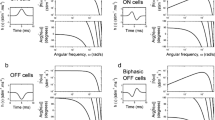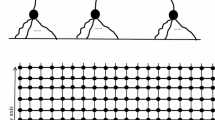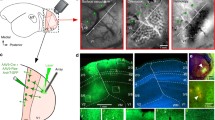Summary
Two types of neuronal lateral inhibition in one-dimensional fields of receptors and neurons are considered. The first type, which has been demonstrated in the eye of Limulus, is called subtractive inhibition (SI): it assumes that neuronal activity depends on the difference between the total excitation and inhibition. The second type is called shunting inhibition (SHI): it assumes that inhibitory influences cause a shunting of a portion of the excitation-produced depolarizing current. Consideration of the shunting model is dictated by its considerable physiological plausibility. The actions of SI and SHI, examined for a variety of coupling conditions and time-stationary positive inputs, are shown to be markedly different. The results indicate that SI is most suited for obtaining (1) a linearity between input and output, (2) a contrasting effect that does not depend on the presence of input discontinuities, and (3) contrasting whose degree is independent of input amplitude. SI is especially useful if coupling coefficients can be varied to accommodate the various input form functions or if, for fixed coupling coefficients, the class of input form functions is limited. On the other hand SHI appears most suited for obtaining (1) a nonlinear input-output relation, (2) a relative contrasting only of discontinuities, and (3) a dependence of the contrasting upon input amplitude.
Similar content being viewed by others
Abbreviations
- a :
-
coupling coefficient for neighboring units, also called coupling amplitude
- V j :
-
output of receptor number j
- i j :
-
generator current of neuron number j
- g :
-
inhibitory function for subtractive inhibition
- h :
-
inhibitory function for shunting inhibition
- ϱ :
-
v 2/v 1 [applies to two-unit case]
- N k :
-
neuron number k
- I k :
-
total source current produced by excitatory influences on N k
- G k :
-
conductance for source current not shunted (with shunting inhibition)
- i σ :
-
portion of source current shunted as a result of inhibition
- m :
-
number of inhibitory influences [in Eq. (1)]
- G kj :
-
conductance of inhibitory shunt path j for neuron N k
- q :
-
number of receptors
- n :
-
number of neurons
- R j :
-
receptor number j
- x :
-
distance
- y(x) :
-
input stimulus to receptors
- y j =y(x j ):
-
input stimulus to receptor R j
- v ⋆ j :
-
vj for v ⋆j ≧0, zero otherwise
- a kj :
-
G kj /v ⋆j , inhibitory coupling coefficient for forward shunting inhibition [refer to Eq. (2)]
- b kj :
-
excitatory coupling coefficient for contribution to source current of neuron N k by receptor R j [refer to Eq. (3)]
- i ⋆ j :
-
i j for i ⋆ j ≧0, zero otherwise
- c kj :
-
G kj /i ⋆ j , inhibitory coupling coefficient for backward shunting inhibition [refer to Eq. (4)]
- â kj :
-
inhibitory coupling coefficient for forward subtractive inhibition [refer to Eq. (5)]
- ĉ kj :
-
inhibitory coupling coefficient for backward subtractive inhibition [refer to Eq. (6)]
- y(x j )=Af(x j ):
-
sensory input function
- A :
-
input amplitude
- f(x j ):
-
sensory input form function, also called a sensory image
- i(x j ):
-
generator current output of neuron Nj which is located at x=x j
- y :
-
(y 1, y 2, ..., y n), a column vector
- i :
-
(i 1, i 2, ..., i n), a column vector, also called generator current configuration
- a :
-
an n by n matrix having a kj as the term in the k-th row, j-th column
- U :
-
the unit matrix
- d :
-
¦k-j¦, separation between neurons N k and N j
- a :
-
a kj for d=1, called coupling amplitude
- SI:
-
subtractive inhibition
- SHI:
-
shunting inhibition
- FSI:
-
forward subtractive inhibition
- BSI:
-
backward subtractive inhibition
- FSHI:
-
forward shunting inhibition
- BSHI:
-
backward shunting inhibition
- s :
-
i/i 51 = (s 1, s 2, ..., s n), normalized generator current vector, also called normalized generator current configuration
- s j :
-
i j/i 51, normalized generator current of neuron N j
- f(x) :
-
continuous input form function of which f(x j ) is a sampled version
- ∂ pf(x)/∂xp :
-
p-th order derivative of f(x)
References
Hartline, H. K., H. G. Wagner, and F. Ratliff: Inhibition in the eye of Limulus. J. Gen. Physiol. 39, 651 (1956).
Ratliff, F., and H. K. Hartline: The responses of Limulus optic nerve fibers to patterns of illumination on the receptor mosaic. J. Gen. Physiol. 42, 1241 (1959).
Hartline, H. K., F. Ratliff, and W. H. Miller: Inhibitory interaction in the retina and its significance in vision. In: Nervous inhibition (E. Florey, Editor), p. 241. New York: Pergamon Press 1961.
Reichardt, W.: Über das optische Auflösungsvermögen der Facettenaugen von Limulus. Kybernetik 1, 57 (1961).
Reichardt, W., u. G. Mac Gintie: Zur Theorie der lateralen Inhibition. Kybernetik 1, 155 (1962).
Varyú, D.: Vergleich zweier Modelle für laterale Inhibition. Kybernetik 1, 200 (1962).
Kirschfeld, K., u. W. Reichardt: Die Verarbeitung stationärer optischer Nachrichten im Komplexauge von Limulus. Kybernetik 2, 43 (1964).
Lettvin, J. Y.: Form-function relations in neurons. Mass. Inst. Technol. Res. Lab. Electron. Quart. Progr. Rept. No 66, 333 (15 July, 1962).
Furman, G. G., and L. S. Frishkopf: Model of neural inhibition in the mammalian cochlea. J. Acoust. Soc. Am. 36, 2194 (1964).
Furman, G. G., and G. Sperling: Nonlinear model for visual intensity discrimination. (Unpublished work.)
Mach, E.: Über die Wirkung der räumlichen Verteilung des Lichtreizes auf die Netzhaut. I. S.-B. Akad. Wiss. Wien, math.nat. Kl. 52, 303 (1865).
Kuffler, S. W.: Discharge patterns and functional organization of mammalian retina. J. Neurophysiol. 16, 37 (1953).
Barlow, H. B., R. FitzHugh, and S. W. Kuffler: Change of organization in the receptive fields of the cat's retina during dark adaptation. J. Physiol. (Lond.) 137, 338 (1957).
Békésey, G. v.: Funneling in the nervous system and its role in loudness and sensation intensity on the skin. J. Acoust. Soc. Am. 30, 399 (1958).
Mountcastle, V. B., and T. P. S. Powell: Neural mechanisms subserving cutaneous sensitibility, with special reference to the role of afferent inhibition in sensory perception and discrimination. Bull. Johns Hopk. Hosp. 105, 201 (1960).
Katsuki, Y., N. Suga, and Y. Kanno: Neural mechanisms of the peripheral and central auditory system in monkeys. J. Acoust. Soc. Am. 34, 1396 (1962).
Katsuki, Y.: Nature of primary auditory neurons in the monkey. J. Acoust. Soc. Am. 35, 793(A) (1963).
Rupert, A., G. Moushegian, and R. Galambos: Unit responses to sound from auditory nerve of the cat. J. Neurophysiol. 26, 449 (1963).
Frishkopf, L. S.: Excitation and inhibition of primary auditory neurons in the little brown bat. J. Acoust. Soc. Am. 36, 1016(A) (1964).
Eccles, J. C.: The synaptic mechanism for postsynaptic inhibition. In: Nervous inhibition (E. Florey, Editor), p. 71. New York: Pergamon Press 1961.
Eyzaguirre, C.: Excitatory and inhibitory processes in crustacean sensory nerve cells. In: Nervous inhibition (E. Florey, Editor), p. 285. New York: Pergamon Press 1961.
Fatt, P.: The change in membrane permeability during the inhibitory processes in crustacean sensory nerve cells. In: Nervous inhibition (E. Florey, Editor), p. 87. New York: Pergamon Press 1961.
Mach, E.: The analysis of sensation, p. 218. (Translation.) New York: Dover Publications, Inc. 1959.
Author information
Authors and Affiliations
Rights and permissions
About this article
Cite this article
Furman, G.G. Comparison of models for subtractive and shunting lateral-inhibition in receptor-neuron fields. Kybernetik 2, 257–274 (1965). https://doi.org/10.1007/BF00274089
Received:
Issue Date:
DOI: https://doi.org/10.1007/BF00274089




